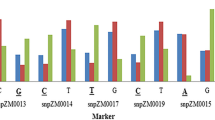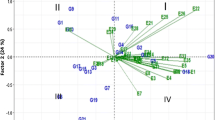Abstract
Biofortification for pro-vitamin A content (pVAC) of modern maize inbreds and hybrids is a feasible way to deal with vitamin A deficiency in rural areas in developing countries. The objective of this study was to evaluate the probability of success of breeding strategies when transferring the high pVAC present in donors to elite modern-adapted lines. For this purpose, a genetic model was built based on previous genetic studies, and different selection schemes including phenotypic selection (PS) and marker-assisted selection (MAS) were simulated and compared. MAS for simultaneously selecting all pVAC genes and a combined scheme for selecting two major pVAC genes by MAS followed by ultra performance liquid chromatography screening for the remaining genetic variation on pVAC were identified as being most effective and cost-efficient. The two schemes have 83.7 and 84.8% probabilities of achieving a predefined breeding target on pVAC and adaptation in one breeding cycle under the current breeding scale. When the breeding scale is increased by making 50% more crosses, the probability values could reach 94.8 and 95.1% for the two schemes. Under fixed resources, larger early generation populations with fewer crosses had similar breeding efficiency to smaller early generation populations with more crosses. Breeding on a larger scale was more efficient both genetically and economically. The approach presented in this study could be used as a general way in quantifying probability of success and comparing different breeding schemes in other breeding programs.



Similar content being viewed by others
References
Bai L, Kim E, DellaPenna D, Brutnell TP (2009) Novel lycopene epsilon cyclase activities in maize revealed through perturbation of carotenoid biosynthesis. Plant J 59:588–599
Bernardo R (2002) Breeding for quantitative traits in plants. Stemma Press, Woodbury
Bouis HE, Welch RM (2010) Biofortification—a sustainable agricultural strategy for reducing micronutrient malnutrition in the global South. Crop Sci 50:S20–S32
Brenna OV, Bernardo N (2004) Application of near-infrared spectroscopy (NIRS) to the evaluation of carotenoids in maize. J Agric Food Chem 52:5577–5582
Buckner B, Kelson TL, Robertson DS (1990) Cloning of the y1 locus of maize, a gene involved in the biosynthesis of carotenoids. Plant Cell 2:867–876
Chander S, Guo Y, Yang X, Zhang J, Lu X, Yan J, Song T, Rocheford T, Li J (2008a) Using molecular markers to identify two major loci controlling carotenoid contents in maize grain. Theor Appl Genet 116:223–233
Chander S, Meng Y, Zhang Y, Yan J, Li J (2008b) Comparison of nutritional trait variability in selected eighty-seven inbreds from Chinese maize (Zea mays L.) germplasm. J Agric Food Chem 56:6506–6511
Egesel CO, Wong JC, Lambert RJ, Rocheford TR (2003) Combining ability of maize inbreds for carotenoids and tocopherols. Crop Sci 43:818–823
Gao S, Martinez C, Skinner DJ, Krivanek AF, Crouch JH, Xu Y (2008) Development of a seed DNA-based genotyping system for marker-assisted selection in maize. Mol Breed 22:477–494
Hallauer AR (2007) History, contribution, and future of quantitative genetics in plant breeding: lessons from maize. Crop Sci 47:S5–S19
Harjes CE, Rocheford TR, Bai L, Brutnell TP, Kandianis CB, Sowinski SG, Stapleton AE, Vallabhaneni R, Williams M, Wurtzel ET, Yan J, Buckler ES (2008) Natural genetic variation in lycopene epsilon cyclase tapped for maize biofortification. Science 319:330–333
Huehn M (1996) Optimum number of crosses and progeny per cross in breeding self-fertilizing crops. I. General approach and first numerical results. Euphytica 91:365–374
Kurilich AC, Juvik JA (1999) Quantification of carotenoid and tocopherol antioxidants in Zea mays. J Agric Food Chem 47:1948–1955
Li Z, Matthews PD, Burr B, Wurtzel ET (1996) Cloning and characterization of a maize cDNA encoding phytoene desaturase, an enzyme of the carotenoid biosynthetic pathway. Plant Mol Biol 30:269–279
Li H, Ye G, Wang J (2007a) A modified algorithm for the improvement of composite interval mapping. Genetics 175:361–374
Li F, Murillo C, Wurtzel ET (2007b) Maize Y9 encodes a product essential for 15-cis zeta-carotene isomerization. Plant Physiol 144:1181–1189
Menkir A, Liu W, White WS, Dixon BM, Rocheford T (2008) Carotenoid diversity in tropical-adapted yellow maize inbred lines. Food Chem 109:521–529
Pfeiffer WH, McClafferty B (2007) HarvestPlus: breeding crops for better nutrition. Crop Sci 47:S88–S105
Pixley K, Babu R, Yan J, Palacios-Rojas N (2010) Challenges, progress, & state of breeding for pro-vitamin A. First Global Conference on Biofortification: From Discovery to Delivery, 9–11 Nov. 2010. Washington, D.C.
Podlich DW, Cooper M (1998) QU-GENE: a platform for quantitative analysis of genetic models. Bioinformatics 14:632–653
Sun ZR, Gantt E, Cunningham FX (1996) Cloning and functional analysis of the β-carotene hydroxylase of Arabidopsis thaliana. J Biol Chem 271:24349–24352
Tallada JG, Palacios-Rojas N, Armstrong PR (2009) Prediction of maize seed attributes using a rapid single kernel near infrared instrument. J Cereal Sci 50:381–387
Tian L, DellaPenna D (2001) Characterization of a second carotenoid β-hydroxylase gene from Arabidopsis and its relationship to the LUT1 locus. Plant Mol Biol 47:379–388
Wang J, van Ginkel M, Podlich D, Ye G, Trethowan R, Pfeiffer W, DeLacy IH, Cooper M, Rajaram S (2003) Comparison of two breeding strategies by computer simulation. Crop Sci 43:1764–1773
Wang J, van Ginkel M, Trethowan R, Ye G, DeLacy I, Podlich D, Cooper M (2004) Simulating the effects of dominance and epistasis on selection response in the CIMMYT Wheat Breeding Program using QuCim. Crop Sci 44:2006–2018
Wang J, Chapman SC, Bonnett DB, Rebetzke GJ, Crouch J (2007) Application of population genetic theory and simulation models to efficiently pyramid multiple genes via marker-assisted selection. Crop Sci 47:580–588
Wang J, Singh RP, Braun HJ, Pfeiffer WH (2009a) Investigating the efficiency of the single backcrossing breeding strategy through computer simulation. Theor Appl Genet 118:683–694
Wang J, Chapman SC, Bonnett DG, Rebetzke GJ (2009b) Simultaneous selection of major and minor genes: use of QTL to increase selection efficiency of coleoptile length of wheat (Triticum aestivum L.). Theor Appl Genet 119:65–74
Weber WE (1979) Number and size of cross progenies from a constant total number of plants manageable in a breeding program. Euphytica 28:453–456
Weber EJ (1987) Carotenoids and tocols of corn grain determined by HPLC. J Am Oil Chem Soc 64:1129–1134
Wong JC, Lambert RJ, Wurtzel ET, Rocheford TR (2004) QTL and candidate genes phytoene synthase and ζ-carotene desaturase associated with the accumulation of carotenoids in maize. Theor Appl Genet 108:349–359
Wurtzel E (2010) Maize: a model cereal crop for developing strategies to solve global vitamin A deficiency. First Global Conference on Biofortification: From Discovery to Delivery, 9–11 Nov. 2010. Washington, D.C.
Yan J, Kandianis CB, Harjes CE, Bai L, Kim EH, Yang X, Skinner DJ, Fu Z, Mitchell S, Li Q, Salas-Fernandez MG, Zaharieva M, Babu R, Fu Y, Palacios N, Li J, DellaPenna D, Brutnell T, Buckler ES, Warburton ML, Rocheford T (2010) Rare genetic variation at Zea mays crtRB1 increases β-carotene in maize grain. Nat Genet 42:322–327
Yonezawa K, Yamagata H (1978) On the number and size of cross combinations in a breeding programme of self-fertilizing crops. Euphytica 27:113–116
Acknowledgments
The authors wish to thank Dr. Kevin Pixley for his constructive comments and suggestions to a draft of the manuscript. This research was supported by the HarvestPlus Challenge Program of CGIAR. Development of the simulation tool QuHybrid was funded by the Generation Challenge Program (GCP) of CGIAR.
Author information
Authors and Affiliations
Corresponding author
Additional information
Communicated by M. Frisch.
Rights and permissions
About this article
Cite this article
Zhang, X., Pfeiffer, W.H., Palacios-Rojas, N. et al. Probability of success of breeding strategies for improving pro-vitamin A content in maize. Theor Appl Genet 125, 235–246 (2012). https://doi.org/10.1007/s00122-012-1828-4
Received:
Accepted:
Published:
Issue Date:
DOI: https://doi.org/10.1007/s00122-012-1828-4




